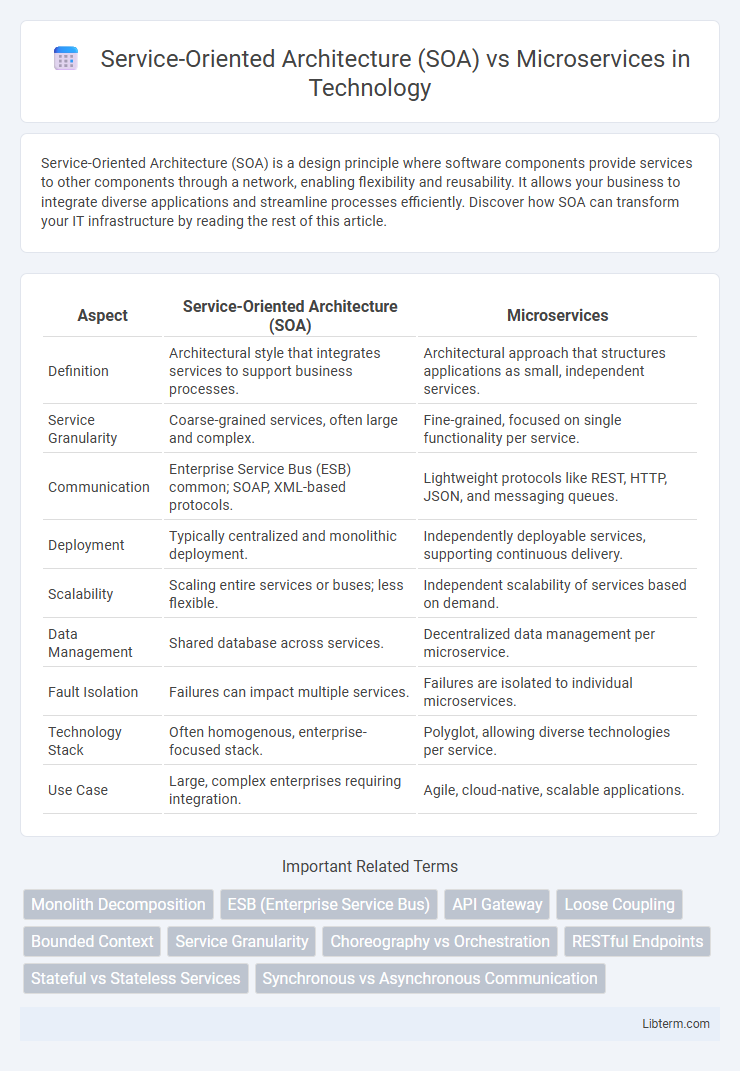Service-Oriented Architecture (SOA) is a design principle where software components provide services to other components through a network, enabling flexibility and reusability. It allows your business to integrate diverse applications and streamline processes efficiently. Discover how SOA can transform your IT infrastructure by reading the rest of this article.
Table of Comparison
| Aspect | Service-Oriented Architecture (SOA) | Microservices |
|---|---|---|
| Definition | Architectural style that integrates services to support business processes. | Architectural approach that structures applications as small, independent services. |
| Service Granularity | Coarse-grained services, often large and complex. | Fine-grained, focused on single functionality per service. |
| Communication | Enterprise Service Bus (ESB) common; SOAP, XML-based protocols. | Lightweight protocols like REST, HTTP, JSON, and messaging queues. |
| Deployment | Typically centralized and monolithic deployment. | Independently deployable services, supporting continuous delivery. |
| Scalability | Scaling entire services or buses; less flexible. | Independent scalability of services based on demand. |
| Data Management | Shared database across services. | Decentralized data management per microservice. |
| Fault Isolation | Failures can impact multiple services. | Failures are isolated to individual microservices. |
| Technology Stack | Often homogenous, enterprise-focused stack. | Polyglot, allowing diverse technologies per service. |
| Use Case | Large, complex enterprises requiring integration. | Agile, cloud-native, scalable applications. |
Introduction to Service-Oriented Architecture (SOA) and Microservices
Service-Oriented Architecture (SOA) structures software into interoperable services that communicate over a network, enabling reusable business functions and enterprise-wide integration. Microservices architecture decomposes applications into small, independently deployable services focused on specific business capabilities, promoting agility and scalability. Both architectures emphasize modularity but differ in service granularity, communication protocols, and deployment strategies.
Core Principles of SOA
Service-Oriented Architecture (SOA) emphasizes reusable, interoperable services that communicate over a network using standardized protocols such as SOAP and XML, promoting loose coupling and service abstraction. Core principles of SOA include service reusability, service autonomy, standardized service contracts, and service discoverability, enabling efficient enterprise-wide integration. Unlike microservices, which focus on independently deployable, fine-grained services often utilizing RESTful APIs and containerization, SOA prioritizes governance, shared services, and orchestration across heterogeneous systems.
Key Concepts of Microservices Architecture
Microservices architecture structures applications as a collection of loosely coupled services, each focused on a specific business capability and independently deployable. Key concepts include autonomy, decentralized data management, continuous delivery, and the use of APIs for communication between services. Unlike monolithic SOA, microservices emphasize scalability, fault isolation, and technology diversity within a distributed system.
Architectural Differences between SOA and Microservices
Service-Oriented Architecture (SOA) centralizes service management through an enterprise service bus (ESB) facilitating communication, whereas Microservices rely on decentralized, lightweight communication protocols like HTTP/REST or messaging queues. SOA emphasizes coarse-grained services with shared databases and middleware for integration, while Microservices prioritize fine-grained, independently deployable services with decentralized data management. The architectural shift from SOA to Microservices enhances scalability, agility, and fault isolation by promoting smaller, autonomous service development.
Technology Stack Comparison
Service-Oriented Architecture (SOA) typically relies on enterprise service buses (ESBs), XML-based messaging protocols like SOAP, and centralized governance tools, making it well-suited for large-scale, complex integrations. Microservices use lightweight protocols such as REST or gRPC, containerization technologies like Docker, and orchestration platforms such as Kubernetes, enabling agile, scalable deployment and independent service management. The SOA technology stack emphasizes heavyweight middleware and standardized contracts, whereas microservices prioritize decentralized data management and polyglot persistence for greater flexibility.
Scalability and Performance Considerations
Service-Oriented Architecture (SOA) typically features larger, more complex services that can create scalability challenges due to tight coupling and shared resources, while microservices architecture promotes independently deployable, lightweight services allowing for fine-grained scalability and enhanced performance. Microservices leverage containerization and orchestration tools like Kubernetes to dynamically scale individual components based on demand, resulting in lower latency and improved fault isolation. SOA's centralized governance can introduce bottlenecks, whereas microservices optimize resource utilization through decentralized deployment, enhancing overall system responsiveness.
Deployment and Management Strategies
Service-Oriented Architecture (SOA) often relies on centralized deployment and management frameworks, focusing on integrating large, reusable services using enterprise service buses (ESBs) to handle communication and orchestration. Microservices architecture emphasizes decentralized deployment strategies, leveraging containerization tools like Docker and orchestration platforms such as Kubernetes for independent service scaling, maintenance, and continuous delivery. This granular control in Microservices enhances fault isolation and agile management compared to the more monolithic and tightly coupled nature of SOA deployments.
Security Implications in SOA vs Microservices
Service-Oriented Architecture (SOA) typically relies on centralized security models such as enterprise service buses (ESB) with built-in authentication and authorization controls, which can create single points of failure and complex security management. In contrast, Microservices architecture emphasizes decentralized security, implementing lightweight, service-specific security measures like OAuth 2.0 and JSON Web Tokens (JWT) for granular access control and isolation between services. The distributed nature of Microservices demands robust network security, including mutual TLS and API gateways, to mitigate increased attack surfaces and ensure secure inter-service communication.
Use Cases: When to Choose SOA or Microservices
Service-Oriented Architecture (SOA) is ideal for large enterprises requiring seamless integration across diverse legacy systems and complex business processes, leveraging a centralized governance model for robust policy enforcement. Microservices suit agile development environments and startups focused on rapid deployment, scalability, and independent service management with decentralized data storage. Organizations should choose SOA when emphasizing enterprise-wide interoperability and consistency, while microservices excel in cloud-native applications demanding flexibility and continuous delivery.
Future Trends in Distributed Architecture
Service-Oriented Architecture (SOA) and Microservices both emphasize modular design but differ significantly in granularity and deployment scalability. Future trends in distributed architecture will highlight increased adoption of event-driven architectures and serverless computing to enhance scalability and reduce latency in microservices-based systems. Integration of AI-driven orchestration and advanced API gateways is expected to optimize service management and improve fault tolerance across both SOA and microservices ecosystems.
Service-Oriented Architecture (SOA) Infographic

 libterm.com
libterm.com